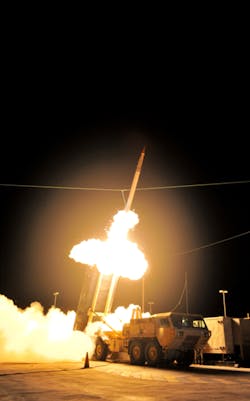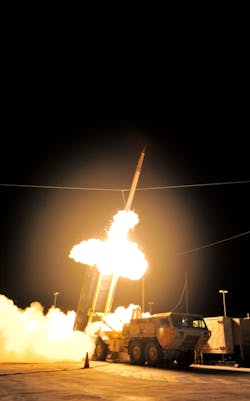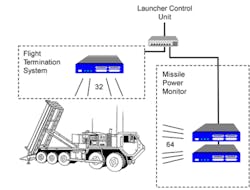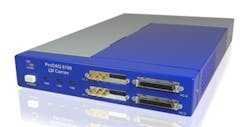The importance of product testing becomes far more intense when the product is a ground-based missile defense system developed to preserve the safety and well-being of a country. One such type of missile defense system, designed by a leading aerospace manufacturer, uses hit-to-kill technology and relies upon the kinetic energy of impact, rather than warheads, to destroy enemy missiles. The missile defense system, sometimes referred to as Kinetic Kill technology, defends the United States against ballistic missile attacks.
Test of a THAAD Missile Defense Interceptor Launch at the Pacific Missile Range Facility in Kauai, Hawaii
Courtesy of the U.S. Missile Defense Agency
According to the Missile Defense Agency of the U.S. Department of Defense, there has been an increase of more than 1,200 ballistic missiles worldwide in the last five years. It also is estimated that the number of ballistic missiles outside of the United States, the North Atlantic Treaty Organization (NATO), Russia, and China has risen more than 5,900, leading to an increased sense of urgency for effective missile defense systems.
Developing a system to test missiles—ensuring control so that missiles fire only when launched and that the correct launch signals are directed to the corresponding missiles—supports the capability the United States must maintain to protect against weapons of mass destruction.
Developing the Test System
To reach that goal, the aerospace manufacturer created a compact missile launcher test system to test the four main components of the missile defense system including the interceptor, launcher, radar, and fire control system (Figure 1). The fire control system is the communications and data-management backbone that links the missile defense components together and connects them to the missile defense system. For that reason, highly accurate data acquisition and sampling are important requirements of the test system.
Figure 1. System Diagram
Initially, the missile test system was based on VXI, but the aerospace manufacturer has since made the simple switch to LXI (LAN eXtensions for Instrumentation) to take advantage of the platform’s reduced size and cost while achieving the same performance.
The LXI-based test system uses a total of 96 data acquisition channels to continually monitor the missile defense system’s voltage and current to ensure that it is receiving power and operating properly. To achieve this, the aerospace manufacturer has implemented two of Bustec’s ProDAQ 6100 LXI function card carriers (Figure 2) that provide access to four ProDAQ 3416 ADC function cards with 16 simultaneous analog inputs each, for a total of 64 available channels in the missile power monitor. A third ProDAQ 6100 function card carrier contains two more ProDAQ 3416 function cards to provide 32 additional data acquisition channels to function as the flight termination system that will disengage the system in the case of an emergency.
Figure 2. Bustec’s ProDAQ 6100 LXI Carrier
The Benefits of LXI
LXI overcomes many of the limitations and costs inherent to GPIB and rack-based instruments. GPIB systems limit the physical distance between devices and the number of devices on the bus and require special cables and controllers, which add cost to the overall system. Based on Ethernet/LAN, LXI systems have an infrastructure composed of low-cost Ethernet cables and switches that are readily available in the consumer electronic industry.
By using the small form factor of the ProDAQ 6100 LXI function card carrier, the aerospace manufacturer is able to perform missile launcher testing for thousands of dollars less than it would using a similar system with PXI or VXI.
Currently, LXI instruments are available with Ethernet speeds of 100 Mb/s and 1 Gb/s. The present Ethernet infrastructure features speeds up to 10 Gb/s and will be even faster in the future. As a result of the increasing network speeds, LXI instruments also have much faster block data transfer rates than instruments using slower buses such as GPIB.
LXI’s support for distributed processing of measurement data and fast data transfer rates make it the platform of choice for remote application testing like the missile defense system, which is globally transportable to anywhere in the world via land, air, and sea. During missile defense system testing, the aerospace manufacturer powers up the missile and takes current and voltage measurements using the missile power monitor. The collected data then can be transferred using a standard Ethernet connection to anywhere in the world for further analysis before the missile is powered up a second time and consequently launched.
Conclusion
With the continued proliferation of ballistic missiles around the world, missile defense systems and their testing are strategic to the U.S. Army’s plan to protect the United States and its allies against incoming enemy missile attacks. LXI provides a compact, portable, and low-cost test solution that enables the aerospace manufacturer to efficiently and accurately test the missile launch and ensure its effectiveness against an enemy, or even accidental, missile strike. With its proven hit-to-kill technology, missile defense systems are the only defense in times of crisis and will hopefully devalue and detract from future missile investments in other parts of the world.
About the Author
Fred Bloennigen, Ph.D., is CEO of Bustec. He earned a doctorate in physics in France and later was employed at the University of California/Berkeley as a nuclear and elementary particle physicist. Back in Europe, he worked for a large American data-acquisition and test company for several years. Dr. Bloennigen founded Bustec in Ireland in 1997 and opened a branch in the United States in 2000. [email protected]



